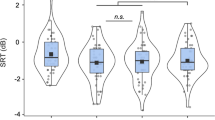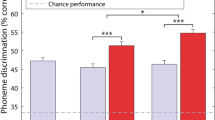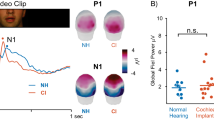Abstract
The totally deafened adult, unable to make use of a hearing aid, has no alternative to lipreading for everyday communication. Lipreading, however, is no substitute for hearing speech. Many lipreaders have great difficulty in ideal conditions and even the best lipreaders find the task demanding and tiring. Prosthetic attempts to substitute for lost hearing have centred on three distinct types of intervention, visual1,2, tactile3–6 and electrocochlear7–13. As none of these is likely to yield a good understanding of speech independent of lipreading in the near future, we have attempted to isolate relatively simple patterns of stimulation that, although not intelligible in themselves, will aid lipreading. From this point of view, the fundamental frequency or ‘pitch’ of the voice is the most important pattern element because it provides both segmental and suprasegmental information and is practically invisible. It thus complements the visual information already available on the face. As we show here, with the voice pitch presented acoustically, normal listeners can lipread a speaker reading a continuous text at up to two and a half times the rate possible on the basis of lipreading alone. The pitch signal by itself, of course, is completely unintelligible. Although our work is primarily concerned with methods of electrical stimulation of the cochlea10, it has implications for other sensory substitution techniques, the design of special purpose hearing aids and current theories of speech perception.
This is a preview of subscription content, access via your institution
Access options
Subscribe to this journal
Receive 51 print issues and online access
$199.00 per year
only $3.90 per issue
Buy this article
- Purchase on Springer Link
- Instant access to full article PDF
Prices may be subject to local taxes which are calculated during checkout
Similar content being viewed by others
References
Upton, H. W. Am. Ann. Deaf 113, 222–229 (1968).
Martony, J. et al. in Speech Communication Seminar Vol. 4, 93–96 (Almqvist-Wiksell, Uppsala, 1974).
De Filippo, C. L. & Scott, B. L. J. acoust. Soc. Am. 63, 1186–1192 (1978).
Kirman, J. H. Psychol. Bull. 80, 54–74 (1973).
Rothenberg, M. & Molitor, R. D. J. acoust. Soc. Am. 66, 1029–1038 (1979).
Sparks, D. W., Ardell, L. A., Bourgeois, M., Wiedmer, B. & Kuhl, P. K. J. acoust. Soc. Am. 65, 810–815 (1979).
Chouard, C. H. & MacLeod, P. Laryngoscope 86, 1743–1751 (1976).
Clark, G. M. et al. J. Lar. Otol. 91, 935–946 (1977).
Eddington, D. K., Dobelle, W. H., Brackmann, D. E., Mladejovsky, M. G. & Parkin, J. L. Ann. Otol. Rhinol. Lar. 87, Suppl. 53, 1–39 (1978).
Fourcin, A. J. et al. Br. J. Audiol. 13, 85–107 (1979).
House, W. F. Ann. Otol. Rhinol. Lar. 85, Suppl. 27, 1–93 (1976).
Merzenich, M. M., Michelson, R. P., Schindler, R. A., Petit, C. R. & Reid, M. Ann. Otol. Rhinol. Lar. 82, 486–503 (1973).
Simmons, F. B. Archs Otolar. 84, 22–76 (1966).
Jeffers, J. & Barley, M. Speechreading (Lipreading) (Thomas, Illinois, 1978).
Fourcin, A. J. in The Development of Communication (eds Waterson, N. & Snow, C.) 47–72 (Wiley, Chichester, 1978).
Fourcin, A. J. & Abberton, E. Med. biol. Illust. 21, 172–182 (1981).
Gold, A. A. & Rabiner, L. R. J. acoust. Soc. Am. 46, 442–448 (1969).
Spens, K.-E. Q. Prog. Status Rep., 2–3 (Speech Transmission Laboratory, Royal Institute of Technology, Stockholm, 1975).
Stratton, W. D. Volta Rev. 76, 26–35 (1974).
Fourcin, A. J. in Language, Cognitive Deficits and Retardation (ed. O'Connor, N.) 33–46 (Butterworth, London, 1974).
Bilger, R. C. Ann. Otol. Rhinol. Lar. 86, Suppl. 38, 1–176 (1977).
Author information
Authors and Affiliations
Rights and permissions
About this article
Cite this article
Rosen, S., Fourcin, A. & Moore, B. Voice pitch as an aid to lipreading. Nature 291, 150–152 (1981). https://doi.org/10.1038/291150a0
Received:
Accepted:
Issue Date:
DOI: https://doi.org/10.1038/291150a0
This article is cited by
-
Improved tactile speech perception using audio-to-tactile sensory substitution with formant frequency focusing
Scientific Reports (2024)
-
Improving speech perception for hearing-impaired listeners using audio-to-tactile sensory substitution with multiple frequency channels
Scientific Reports (2023)
-
Is song processing distinct and special in the auditory cortex?
Nature Reviews Neuroscience (2023)
-
Real-time pre-processing for improved feature extraction of noisy speech
International Journal of Speech Technology (2021)
-
Haptic wearables as sensory replacement, sensory augmentation and trainer – a review
Journal of NeuroEngineering and Rehabilitation (2015)
Comments
By submitting a comment you agree to abide by our Terms and Community Guidelines. If you find something abusive or that does not comply with our terms or guidelines please flag it as inappropriate.



